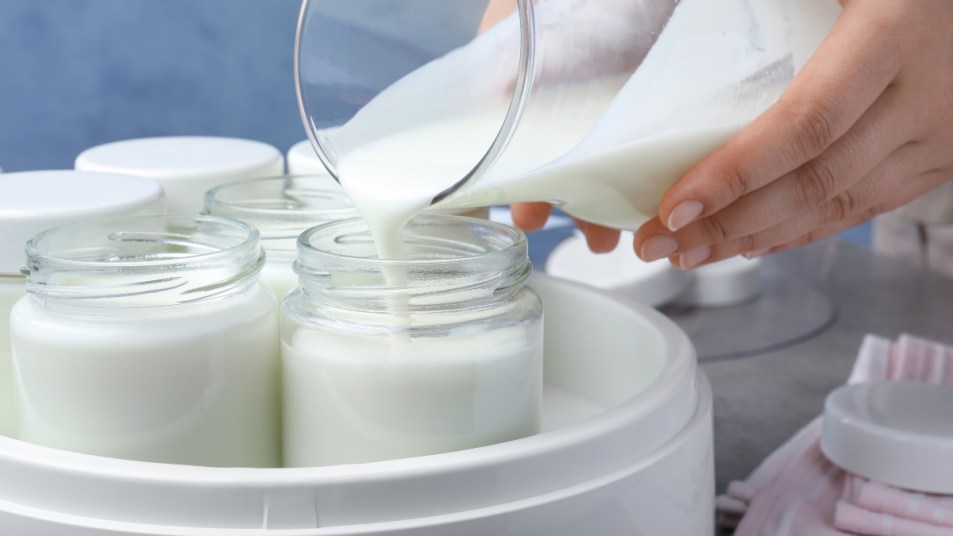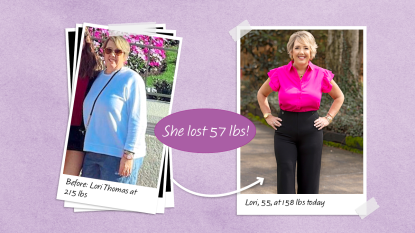Never Buy Probiotics Again — Use This Simple Process to Make Yogurt At Home and Boost Your Gut Health
It's customizable to fit your needs, and it may pay for itself.

You know that probiotics are good for your gut health, oral health and more. But how much money do you spend on probiotics? It might not seem like a lot, but the cost adds up over time. These supplements have an average retail price of $33.69 for 50 capsules — that’s not even a two month supply. Buying a tub of yogurt each week might be less expensive, but there’s another option: making your own yogurt at home.
If you’re worried that making yogurt sounds like a gigantic school project, think again. Once you get the hang of it, it’s a breeze. “Making yogurt is really a simple process. The results are delicious, and the health effects? Spectacular,” says Super Gut author William Davis, MD. He says beginners can make their yogurt with just one probiotic called L. reuteri. “This strain alone delivers smoother skin, accelerated healing, higher energy, and a more relaxed and happy mood.” (Click through to learn why probiotic-rich foods like yogurt are one of the best ways to treat anxiety naturally, lower cortisol and eliminate bad breath from the stomach, too.)
Of course, making any sort of fermented food at home requires strict safety procedures. Continue reading to understand the full process so you can get cooking.
The Benefits of Homemade Yogurt
It’s customizable. “Homemade yogurt can be customized to suit your specific health goals,” says Dr. Davis. For example, you can add L. gasseri BNR17. This probiotic strain helps with stubborn GI issues. According to Dr. Davis, it may also help you lose weight.
It may help with joint pain. Have joint pain? Consider including B. coagulans GBI- 30,6086. “This specific strain gives people true relief,” Dr. Davis says. “You’ll just have so much energy, and you’ll want to be more active, so it helps with weight loss, too.”
Over time, it may pay for itself. No need to keep buying probiotics over and over: Once you’ve made yogurt, just save a couple dollops to use like sourdough ‘starter’ for your next batch. To do: Use 2 tablespoons of yogurt in place of the supplements called for in the recipe below.
(Click through to learn how yogurt can balance your vaginal pH, improve your mood better than an antidepressant and help calm heartburn.)
Tools for Making Yogurt at Home
To get started, you’ll need a device that can maintain 106 degrees Fahrenheit for 36 hours. That’s the perfect time and temperature to ferment your ingredients and create the most potent results. (If it’s too cold, the probiotics won’t grow; if it’s too hot, they die.)
Dr. Davis’ devotees report getting best results with a sous vide gadget, which provides a precisely heated water bath and not only makes yogurt but also perfectly cooks veggies and meat. We like the Instant Accu Slim Sous Vide 800W Precision Cooker, $100 (Buy from Amazon, $99.99).
Prefer a cheaper option? Go for a yogurt maker that lets you fully control time and temperature, like Suteck (Buy from Walmart, $42.99). You may want to use a thermometer to test the yogurt temperature after it’s fermented an hour; adjust if it gets too hot.
Once you have your device, simply follow the recipe below. You can find more information at DrDavisInfiniteHealth.com. Says the doc, “I have made countless batches of this without a single failure. You absolutely can do this.”
Related: Is Yogurt Good for Constipation? Yes — And So Are These 9 Other Foods
Homemade Yogurt Recipe
Use up to three different strains of probiotics in your yogurt to turbocharge results.
Ingredients (serves 8):
- 10 BioGaia Gastrus L. reuteri tablets, crushed
- Contents of 1 L. gasseri BNR17 capsule (optional)
- Contents of 1 B. coagulans GBI- 30,6086 capsule (optional)
- 2 tablespoons prebiotic fiber, such as Now brand inulin powder (Buy from iHerb, $7.83)
- 1 quart half-and-half or coconut cream (such as Savoy brand)
Instructions:
- Stir together probiotics, fiber and 2 tablespoons of milk/cream until dissolved (this prevents fiber from clumping). Stir in remaining liquid.
- Divide mixture among glass jars that fit in your device or a large pot for sous vide method. Cover jars loosely with plastic or a mesh screen top.
- Add jars to yogurt maker or pot with water an inch or two from jar tops. Set device to heat at 106 degrees Fahrenheit for 36 hours (48 hours if using coconut cream).
Troubleshooting
- Milk forming clumps or strings during the heating process? Some of the milk proteins may have jelled. The fix: Pick the solids out with a slotted spoon. Or pour the milk mixture through a clean colander or cheese cloth, then continue heating.
- Yogurt doesn’t set properly? Check the temperature frequently. If it’s low or high, adjust. Your culture starter might also be poor quality. If you suspect this, start over with a recently purchased yogurt or culture from the grocery store.
- Yogurt tastes or smells bad? The yogurt may have over-incubated or set for too long. In this case, refrigerate immediately after it has firmed up. Or: Your starter culture may be contaminated. In this case, throw out the batch and start again with a new culture or grocery-store yogurt. (Note: Overheating the yogurt may also cause an off-flavor — it’s safe to eat in this instance, but won’t taste very good. So, you may have to start over anyway.)
For more natural ways to improve gut health:
Benefits of Kombucha for Women: The Sparkling Tea Can Heal Your Gut, Speed Weight Loss
Kefir Smoothies For Weight Loss: 3 Delicious and Nutritious Recipes
6 Low Sugar Fermented Foods Proven to Dramatically Improve Gut Health
This content is not a substitute for professional medical advice or diagnosis. Always consult your physician before pursuing any treatment plan.
A version of this article originally appeared in our print magazine, Woman’s World.













